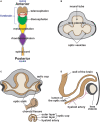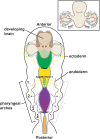The Ocular Neural Crest: Specification, Migration, and Then What?
- PMID: 33425902
- PMCID: PMC7785809
- DOI: 10.3389/fcell.2020.595896
The Ocular Neural Crest: Specification, Migration, and Then What?
Abstract
During vertebrate embryonic development, a population of dorsal neural tube-derived stem cells, termed the neural crest (NC), undergo a series of morphogenetic changes and extensive migration to become a diverse array of cell types. Around the developing eye, this multipotent ocular NC cell population, called the periocular mesenchyme (POM), comprises migratory mesenchymal cells that eventually give rise to many of the elements in the anterior of the eye, such as the cornea, sclera, trabecular meshwork, and iris. Molecular cell biology and genetic analyses of congenital eye diseases have provided important information on the regulation of NC contributions to this area of the eye. Nevertheless, a complete understanding of the NC as a contributor to ocular development remains elusive. In addition, positional information during ocular NC migration and the molecular pathways that regulate end tissue differentiation have yet to be fully elucidated. Further, the clinical challenges of ocular diseases, such as Axenfeld-Rieger syndrome (ARS), Peters anomaly (PA) and primary congenital glaucoma (PCG), strongly suggest the need for better treatments. While several aspects of NC evolution have recently been reviewed, this discussion will consolidate the most recent current knowledge on the specification, migration, and contributions of the NC to ocular development, highlighting the anterior segment and the knowledge obtained from the clinical manifestations of its associated diseases. Ultimately, this knowledge can inform translational discoveries with potential for sorely needed regenerative therapies.
Keywords: anterior segment; neural crest; ocular development; ocular diseases; periocular mesenchyme.
Copyright © 2020 Williams and Bohnsack.
Conflict of interest statement
The authors declare that the research was conducted in the absence of any commercial or financial relationships that could be construed as a potential conflict of interest.
Figures




Similar articles
-
Genetics Underlying the Interactions between Neural Crest Cells and Eye Development.J Dev Biol. 2020 Nov 10;8(4):26. doi: 10.3390/jdb8040026. J Dev Biol. 2020. PMID: 33182738 Free PMC article. Review.
-
Neural crest derivatives in ocular development: discerning the eye of the storm.Birth Defects Res C Embryo Today. 2015 Jun;105(2):87-95. doi: 10.1002/bdrc.21095. Epub 2015 Jun 4. Birth Defects Res C Embryo Today. 2015. PMID: 26043871 Free PMC article. Review.
-
Relationship between neural crest cell specification and rare ocular diseases.J Neurosci Res. 2019 Jan;97(1):7-15. doi: 10.1002/jnr.24245. Epub 2018 Apr 16. J Neurosci Res. 2019. PMID: 29660784 Free PMC article. Review.
-
Evaluating neural crest cell migration in a Col4a1 mutant mouse model of ocular anterior segment dysgenesis.Cells Dev. 2024 Sep;179:203926. doi: 10.1016/j.cdev.2024.203926. Epub 2024 May 9. Cells Dev. 2024. PMID: 38729574 Free PMC article.
-
Compound developmental eye disorders following inactivation of TGFbeta signaling in neural-crest stem cells.J Biol. 2005;4(3):11. doi: 10.1186/jbiol29. Epub 2005 Dec 14. J Biol. 2005. PMID: 16403239 Free PMC article.
Cited by
-
Loss of zebrafish dzip1 results in inappropriate recruitment of periocular mesenchyme to the optic fissure and ocular coloboma.PLoS One. 2022 Mar 14;17(3):e0265327. doi: 10.1371/journal.pone.0265327. eCollection 2022. PLoS One. 2022. PMID: 35286359 Free PMC article.
-
A Fetus with Congenital Microcephaly, Microphthalmia and Cataract Was Detected with Biallelic Variants in the OCLN Gene: A Case Report.Diagnostics (Basel). 2021 Aug 30;11(9):1576. doi: 10.3390/diagnostics11091576. Diagnostics (Basel). 2021. PMID: 34573918 Free PMC article.
-
Single-cell analyses reveal transient retinal progenitor cells in the ciliary margin of developing human retina.Nat Commun. 2024 Apr 26;15(1):3567. doi: 10.1038/s41467-024-47933-x. Nat Commun. 2024. PMID: 38670973 Free PMC article.
-
Treating Glaucoma in Intellectually Disabled Patients: Novel Criteria for Choosing Surgical Candidates.J Ophthalmol. 2025 Jun 9;2025:9752978. doi: 10.1155/joph/9752978. eCollection 2025. J Ophthalmol. 2025. PMID: 40524952 Free PMC article.
-
iPSC-derived cells stimulate ABCG2+/NES+ endogenous trabecular meshwork cell proliferation and tissue regeneration.Cell Prolif. 2024 Jul;57(7):e13611. doi: 10.1111/cpr.13611. Epub 2024 Feb 14. Cell Prolif. 2024. PMID: 38356373 Free PMC article.
References
-
- Baulmann D. C., Ohlmann A., Flugel-Koch C., Goswami S., Cvekl A., Tamm E. R. (2002). Pax6 heterozygous eyes show defects in chamber angle differentiation that are associated with a wide spectrum of other anterior eye segment abnormalities. Mech. Dev. 118 3–17. 10.1016/s0925-4773(02)00260-5 - DOI - PubMed
Publication types
LinkOut - more resources
Full Text Sources

